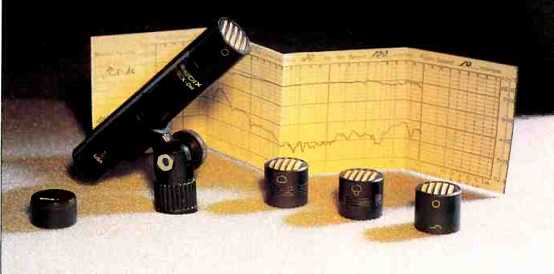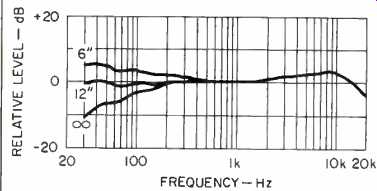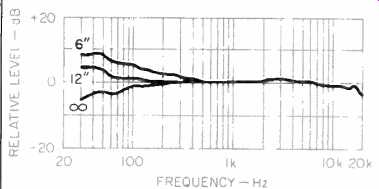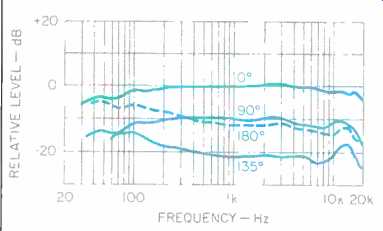
Manufacturer's Specifications:
Type: Condenser with interchange able capsules.
Capsules: Omnidirectional (SCX-o), omnidirectional with added presence (SCX-op), cardioid (SCX-c), and hypercardioid (SCX-hO).
Frequency Response: SCX-o and SCX-op, 20 Hz to 20 kHz; SCX-c and SCX-hc, 40 Hz to 20 kHz.
Sensitivity (re: 1 V/µbar): SCX-o,-60 dB; SCX-op,-58 dB; SCX-c,-56 dB; SCX-hc,-56 dB.
Impedance: 200 ohms.
Equivalent Noise Level: 13 dBA re: 20 micro-pascals (u-Pa).
Maximum Sound Pressure Level (re: 20 µPa): SCX-o and SCX-op, 132 dB; SCX-c and SCX-hc, 130 dB; all figures 10 dB higher with optional 10-dB attenuator.
Power Source: Phantom, 9 to 52 V d.c.
Connections: Integral three-pin XLR male plug at base of preamp housing.
Dimensions: 4 1/8 in. L x 13/16 in. dia. (10.5 cm x 2.1 cm).
Weight: 4 oz. (0.11 kg).
Prices: Preamp section, $500; capsules, $399 each; 10-dB pad, $100; shock mount, $199.95; windscreen and pop filter, $25.
Company Address: 19439 S.W. 90th Ct., Tualatin, Ore. 97062.
The new SCX-One studio condenser microphone from Audix is distinctively short, which the manufacturer attributes to the use of surface-mount technology in the electronics. Audix has their own surface-mount facilities as well as proprietary coil-winding equipment. (Their consumer microphones, however, are imported from Japan.) I reviewed the Audix UD-200S cardioid dynamic microphone for the June 1987 issue and found it had good performance and appeared durable. Since 1988, I have been using Audix OM-1 dynamic mikes in my church auditorium; these microphones have survived relatively rough usage and still sound and look good.
The SCX-One and its interchange able capsules have precision-machined housings and appear to be of high quality. The SCX-One is the first studio condenser offered by Audix and was so new that an instruction manual with detailed data on the unit was not available when I wrote this. The catalog sheet contained some errors and typos (which I've confirmed with the manufacturer); the specs listed at the beginning of this review are correct.
The frequency response curves in the catalog sheet were too small to be of much use, but individually drawn strip charts were included with the microphone system.
In addition to the four capsules, a 10-dB attenuator was furnished, which fits in between the capsule and the preamp. This element is needed only when working with high sound levels, and it increases the maximum SPL from 130 or 132 dB to 140 or 142 dB.
The windscreen, pop screen, and shock mount were not furnished. No cable was furnished, and I found that not all of the cables I had on hand with XLR-type three-pin connectors would fit the mike. This was because the microphone's precision machining did not allow for the size variation among different brands of connectors.
Measurements

Fig. 1--Frequency response with SCX-o omni capsule (0 dB is -35 dBV/Pa).

Fig. 2--Frequency response with SCX-op omni capsule with presence (0 dB
is -38 dBV/Pa).

Fig. 3--Frequency response vs. source distance with SCX-c cardioid capsule
(0 dB is -39 dBV/Pa).

Table I--Comparison of sensitivity figures at 1 kHz, in dB re: 1 V/u-bar.
Audix indicated that it would be best to use a source of phantom power with minimum series resistance so as to maintain the voltage at the mike close to 48 V d.c. For my tests, I used five 9 V batteries connected to the center tap of a high-quality 200:200-ohm isolation transformer. Since I used no resistor between the batteries and the center tap, and since fresh "9-V" batteries are actually a fraction of a volt over that value, I obtained approximately 47 V at the microphone. This arrangement had the advantage of isolating d.c. from my impedance-measuring circuit, which allowed me to ground one side of the mike output for the impedance test.
Normally, I present an impedance curve, but in this case, the magnitude varied so much with frequency that the isolation transformer introduced errors.
After making corrections for the series resistance of the transformer, I estimated the impedance to be about 26 ohms at 1 kHz and above. Below 1 kHz, the impedance increased like a capacitor's, reaching about 1,100 ohms at 20 Hz. In order to avoid bass roll-off, the minimum load resistance on the mike should be about 3 kilohms.
I tested the SCX-One and its capsules using a 2-inch spherical laboratory sound source at distances from 6 to 24 inches. The first capsule tested was the omnidirectional SCX-o. Figure 1 shows that the response is smooth and flat, except that the peak at 8 kHz is about 2.5 dB higher than the response on the factory strip chart. This is an acceptable variation; in my opinion, a microphone of this size should have a peak of this magnitude in the frontal response so that diffraction does not cause the response to have excessive high-frequency roll-off. After translation to a 1-µbar (0.1-Pa) reference, the measured sensitivity was 6 dB higher than was shown on the factory test chart and 5 dB higher than shown on the spec sheet. Table I shows a comparison of three sets of sensitivity data for this and the other three capsules.
Normally, my data agrees with the manufacturer's within 1 or 2 dB. In this case, since my test values show less of a spread than Audix's factory test results do, there appears to be a problem in their testing but not in the micro phones themselves. Despite what Audix's test charts show, the spread of values in the specifications and in my test results is acceptable. This is important to the user, because micro phones with closely matched output levels are desirable for stereo recording and because uniform sensitivity implies uniformity in manufacture.
The frequency response with the SCX-op (omni with presence) capsule is shown in Fig. 2. If the 0° curve were smoothed a bit between 5 and 10 kHz, it would closely match the test curve supplied by the factory. Note that the 90° curve, compared to Fig. 1, indicates the response peaking in this capsule is about 7 dB at 7 kHz. This degree of response equalization is comparable to popular vocal micro phones, so the SCX-op capsule should be appropriate for vocal music and speech. Both omni capsules show linear bass response and will probably pick up subterranean bass. Omnis are the first choice for vocals, as they have no proximity effect (bass boost when used at close distances) and are less responsive to breath blast or "pop." The response of the SCX-c cardioid capsule (Fig. 3) shows a slight rise towards 10 kHz, which is acceptable and perhaps desirable for many uses.
The roll-off above 10 kHz is a bit too steep. The bass response is linear for sources 12 inches away but rolls off for point sources at an "infinite" distance (greater than 4 feet). Since the latter response is calculated for a free field, it is difficult to be certain if it is correct for sound pickup in rooms. Figure 4 indicates good cardioid directional responses for the SCX-c capsule. The individual factory test curve agreed above.
The data for the SCX-hc capsule (Fig. 5) indicates that exceptionally linear frequency response will probably be obtained for sources more than a few feet distant. Figure 6 shows good hypercardioid directional responses.
Note that the "null" is at 135°, not 180° as in the cardioid. The factory test curves showed more linear response for the hypercardioid than for the other capsules, and my curves are in reasonable agreement with them.
To measure the noise of the micro phone, I put it in a sound-attenuating box. The cardioid capsule was used for this test, as it was likely to pick up the least environmental noise at very low frequencies, and the mike was powered by a battery supply to avoid hum. The SCX-One has nearly 20 dB greater sensitivity than a dynamic mike, so noise from my instrument amplifier was not a factor.
The third-octave-band noise spectrum of the SCX-c (Fig. 7) decreases with frequency at a more or less linear rate. The A-weighted equivalent sound pressure level of the noise was calculated to be 25 dB. This was much higher than the manufacturer's rating of 13 dBA, so I tested a second sample and found it to have almost exactly the same noise level. Then, I put a Neumann KM-100 with cardioid capsule and the SCX into the test box. Playing a radio in the test room at low level and using the calibrated attenuator in my microphone amplifier, I determined that the equivalent noise SPL of the Audix was about 10 dB higher than that of the Neumann, a far more expensive mike with a rated noise level of 16 dBA. Therefore, I concluded that my measured noise level for the Audix mike was correct. However, noise from the SCX was not a problem during the listening tests.
The clipping level of the SCX-o omni was measured as 127 dB peak SPL, significantly lower than the rated 132 dB. Of course, inserting the 10-dB attenuator will increase the overload level to 137 dB.

Fig. 4--Frequency response vs. angle, with SCX-c cardioid capsule.

Fig. 5--Axial frequency response vs. source distance with SCX-hc hypercardioid
capsule (0 dB is-37 dBV/Pa).

Fig. 6-Frequency response vs. angle with SCX-hc hypercardioid capsule.

Fig. 7--Third-octave noise spectrum with SCX-c capsule.
Use and Listening Tests
After my tests, I obtained a second SCX microphone set, plus a power supply, so I'd have a stereo pair for recording. The power supply was made by ACO Pacific; Audix does not make or sell power supplies of its own.
This switching supply used one 9-V battery to furnish 48 V d.c. to a pair of microphones; under load, however, the unit delivered only 29 V d.c. at the mikes, much less than my homemade battery supply did. The battery furnished with the supply died on the bench and was replaced with a fresh alkaline. Testing indicated that the audio outputs of the supply were balanced, with the midpoint grounded.
This showed that the mike had an electronically balanced, transformerless circuit. I therefore derived the unbalanced signals for the recorder from one audio line only (pins 2 and 1 of the XLR-type connectors). This avoided shorting the other line (pin 3) to ground (pin 1), which might possibly damage chips in the power supply.
The recorder used was a Sony TCD D3 DAT Walkman, so the entire recording setup needed no a.c. power. Be cause of the SCX-One's high output, I had to switch in the Sony's 20-dB mike input attenuator. This worked well until one channel of the Sony's mike preamp failed, probably due to a switch problem. The line inputs were still good, so the mikes were connected to these inputs with gain at maxi mum. Remarkably, the SCX mikes were able to drive the Sony to its 0-dB level during the taping.
My test recordings were made at a concert at the United Methodist Church in Haddonfield, N.J., a large sanctuary with 900 seats. I mounted the SCX-Ones on a 14-foot stand, used the hypercardioid capsules, and set up the mikes as a coincident pair with a 90° included angle. The Audix mikes were positioned about 2 feet below the permanently flown AKG C-422 stereo microphone. The latter was set as a coincident pair of figure-8 micro phones at 90° (a Blumlein array). The AKG was connected via a Soundcraft 8 x 4 mixing console to a Sony DTC 75ES DAT recorder. The concert included a young persons' choir with soloists, handbells, organ, and piano.
Nearly two hours of tape had been used by intermission. The DAT Walk man's battery, which is rated at two hours per charge, was flat by this time, and the battery in the microphone power supply was also weak.
I was unable to perform a strict NB comparison between the AKG and Audix mikes, as the tape made with the AKG also included some sound from soloists' microphones at times, and .1 had to keep switching the AKG and Audix tapes in and out of the one DAT recorder I had available. Nonetheless, I am pleased that I heard no difference between the tapes, particularly since I consider the AKG to be an exceptional mike.
After the concert, I acquired a Toshiba DX-900 VCR with digital and VHS Hi-Fi sound. Because this unit can record both PCM and Hi-Fi sound simultaneously, with flat response from 20 Hz to 20 kHz on each, it is a valuable tool in comparing two pairs of microphones or in making surround sound recordings.
I used this VCR to make a backup master tape during an organ recording session in the Haddonfield church with Music Director and organist John Wilson. The large Austin pipe organ was recently rebuilt, and some electronic 32-foot stops had been added. I placed a pair of SCX-o omni units in the first row of the rear balcony, which is about 130 feet from the organ pipes.
The mikes were spaced 7 inches apart, facing the organ, and powered by the audio console. The audio from the AKG mike was recorded by the Sony DAT Walkman and by the PCM tracks on the Toshiba VCR. The audio from the SCX mikes was recorded on the Hi-Fi tracks of the VCR as surround channels. The recordings were remarkably similar, save for an excess of very low bass on the SCX tracks, caused by room acoustics. I learned from this experiment that these omni mikes are capable of subterranean bass, as I had expected. I was not surprised that a good stereo recording could be made with slightly spaced omnidirectional microphones, as I had used this technique in reviewing the Bruel & Kjaer Studio Microphones (November 1984 issue).
After I obtained these good results, my colleague Carlton Read used the Audix omnis in recording a string quartet concert at the Presbyterian Church in Haddonfield. The acoustics of this large, 1,000-seat sanctuary had been recently improved. The mikes were spaced about 7 inches apart and were above, in front of, and facing the musicians. The recorder was a battery-operated Marantz cassette unit with Dolby B NR. The recording was technically about the best I've heard from this church. Background noise was not audible, and the stereo perspective was amazingly good. The instruments sounded very live, almost like a DAT recording.
Conclusions
The SCX-One microphone system has excellent frequency response and uniform directional characteristics, comparable to more expensive studio microphones. It is an ideal choice for making on-location concert recordings using a DAT or a PCM/Hi-Fi VCR. The noise levels may be too high for re cording very quiet sources in quiet places but will probably not be noticed in typical concert recording venues.
I hope that by the time you read this review, Audix will have ironed out quality control in factory testing and provided a manual with properly written specifications. I also hope Audix can reduce the noise level and increase the peak SPL, but this may not be possible without increasing the cost. Still, these are small items, and overall this mike offers good performance at a reasonable price.
-Jon R. Sank
(adapted from Audio magazine, Dec. 1992)
Audio-Technica AT813 Microphone (Equip. Profile, Sept. 1982)
Brüel & Kjaer Type 4003 and Type 4007 Studio Condenser Microphones (Nov. 1984)
Microphone SENSITIVITY Ratings (Dec. 1976)
The Compleat Microphone Evaluation (April 1977)
The Compleat Microphone Evaluation--An Update (Sept. 1978)
Miking the PRO Way (Nov. 1977)
A Guide to COINCIDENT MIKES (Nov. 1978)
Build A Microphone Preamp (Feb. 1979)
= = = =